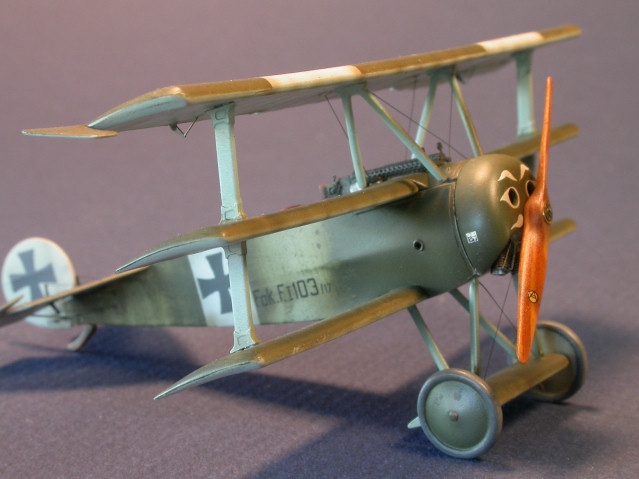
Eduard 1/72 Fokker F.1
| KIT #: | 7015 |
| PRICE: | $12.95 |
| DECALS: | Three options |
| REVIEWER: | Roger Fabrocini (historical section by Tom Cleaver) |
| NOTES: | Roseplane Fokker F.1 update used |

| HISTORY |
Following the decision to produce the Fokker Triplane, Anthony Fokker ordered
his experimental department to produce two V4 prototypes which were
pre-production aircraft and known as the F.I. Ordered on July 11, 1917, they
took five weeks to construct and were given acceptance flights at Schwerin on
August 16. They 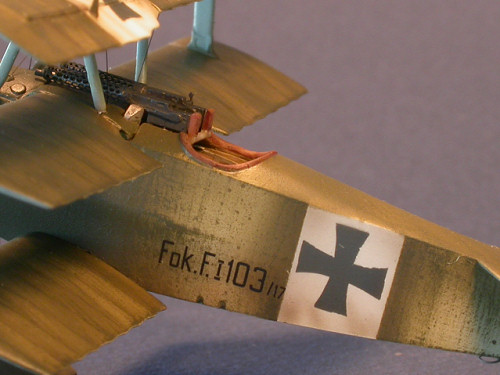 were sent to
Jagdgeschwader I on August 21.
were sent to
Jagdgeschwader I on August 21.
Werner Voss, commander of Jasta 10, made the first flight of a triplane on the evening of August 28. Fokker himself visited the unit on August 31 and gave a flight demonstration.
On September 7, flying F.I/102/17, Manfred von Richtofen scored his 60th victory, an R.E.8. He scored one more victory in the F.I before taking an extended leave that fall. Kurt Wolff was shot down in F.I/102/17 on September 15, 1917.
Werner Voss gave a full demonstration of the Fokker triplane’s potential, scoring 10 victories between August 28 and September 23, 1917 - though there is no record of exactly how many of these were scored in the triplane, which suffered from various glitches and was not flyable every day. An Austrian war document dated October 25, 1917, mentions Voss having shot down three aircraft with the triplane. On the evening of September 23, flying F.I/103/17, he was caught by a six-plane flight from 56 Squadron that included aces squadron leader Captain James McCudden and Captain A.P.F. Rhys-Davids, flying the new S.E.5A.
In
the fight that followed, Voss put on a stunning display of aerobatics, clearly
demonstrating the superior maneuverability of the Triplane as compared with the
S.E.5A through a 20-minute battle, at which point he dove away from the fight.
As Rhys-Davids later reported, “I saw him next with his engine apparently off,
gliding west. I dived again and got one shot out of my Vickers. However, I
reloa ded and kept in the dive. I
got another good burst and the triplane did a slight right-hand turn, still
going down. I now overshot him and never saw him again.” Controversy rages to
this day as to whether the limited fuel capacity of the triplane had resulted in
Voss running out of fuel in the middle of the fight.
ded and kept in the dive. I
got another good burst and the triplane did a slight right-hand turn, still
going down. I now overshot him and never saw him again.” Controversy rages to
this day as to whether the limited fuel capacity of the triplane had resulted in
Voss running out of fuel in the middle of the fight.
Forewarned by Voss’ fight and recovery of the wreckage of his airplane, the Allies knew what to expect when the Dr.I started showing up in small numbers the next month. By the end of October 1917, Fokker’s reputation for shoddy production quality caught up with him again as Dr.Is crashed because of wing and aileron failures. The Dr.I was withdrawn from service in early November to have the wings replaced, and by the time it was re-released for service, the conditions of air combat had rendered it largely irrelevant.
The Germans had copied the Sopwith Triplane and produced the Fokker Triplane at just the time the Sopwith airplane was being removed from service, having been outclassed in combat capability by the Sopwith Camel. With the deaths in combat of Voss and Richtofen while flying Fokker Triplanes, the airplane entered the realm of legend, despite the fact that it was actually a very second-rate design further hobbled by poor production quality.
| THE KIT |
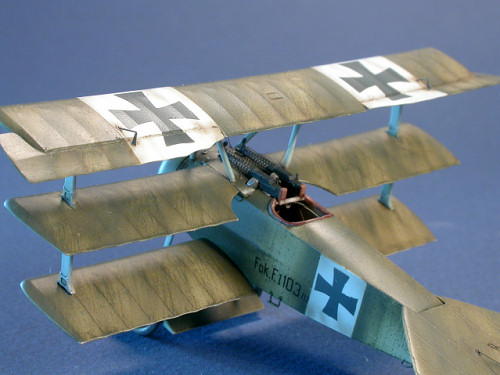 This kit was the initial
Eduard release of their series of Fokker F.I/Dr.I kits. The Profipack kit has
33 plastic parts with a fret of photo-etched parts. Unfortunately, due to the
fact the kit is really a Dr.I, you cannot make a fully-accurate F.1 - the combat
evaluation prototypes - without modification.
This kit was the initial
Eduard release of their series of Fokker F.I/Dr.I kits. The Profipack kit has
33 plastic parts with a fret of photo-etched parts. Unfortunately, due to the
fact the kit is really a Dr.I, you cannot make a fully-accurate F.1 - the combat
evaluation prototypes - without modification.
Roseplane attempts to solve this problem by supplying the parts needed to convert the Eduard kit to an F.I. The F.I differed from the production Dr.I in many ways. Roseplane addresses three of the differences: curved leading edge of the Horizontal stabilizer; ailerons with smaller area and bigger balance horns; revised engine cowling opening.
| CONSTRUCTION |
I construct most of my WWI aircraft in sub-assemblies, paint and mark them, then assemble the sub-assemblies together.
In this case I assembled the fuselage and lower wing, landing gear wing with struts, upper wing with cabane struts and middle wing with interplane struts.
The Profipack set replaces most of the cockpit interior with photo etched parts. Most of the molded plastic detail needs to be chiseled off. I found the fuselage framing part PE18 to be quite delicate, but all parts fit well into the fuselage.
There were no construction ‘snags’ encountered.
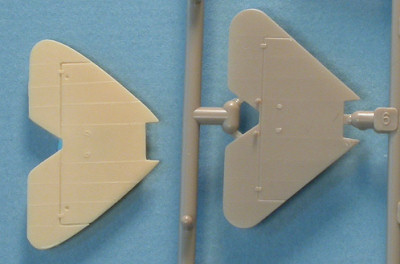 The location holes for the
cabane and landing gear struts are shallow, but Eduard has supplied a one-piece
interplane strut that passes through the middle wing making wing alignment
relatively easy.
The location holes for the
cabane and landing gear struts are shallow, but Eduard has supplied a one-piece
interplane strut that passes through the middle wing making wing alignment
relatively easy.
Photo etched Perforated cooling jackets are supplied for the two Spandau machine gunes, along with cocking handles. They add a bit of finesse to the finished model.
Photo etched detail is also supplied for the Oberursel rotary engine.
Of
the three parts supplied in the Roseplane update set, I eventually only used the
horizontal stabilizer. I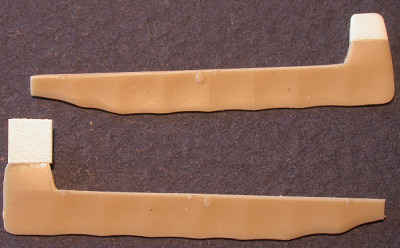 t has
the correctly curved leading edge. I stared long and hard at their cowling and
found little to distinguish it from the kit cowling. At any rate, it does not
have the small reinforced lip on the bottom where the cowling meets the
fuselage. I ended up reshaping the kit cowling with a sanding stick, adding a
more rounded curve to its profile.
t has
the correctly curved leading edge. I stared long and hard at their cowling and
found little to distinguish it from the kit cowling. At any rate, it does not
have the small reinforced lip on the bottom where the cowling meets the
fuselage. I ended up reshaping the kit cowling with a sanding stick, adding a
more rounded curve to its profile.
The last area that Roseplane addresses is the ailerons. Though they have reshaped the trailing edge to match the prototype, they forgot the larger balance horns. I ended up using the Roseplane wing as a guide to reshape the kit ailerons and adding plastic card stock to the balance horns and reshaping them too. While I was at it, I cut and repositioned the ailerons.
The limited rigging is .002" monofilament, painted black.
| COLORS & MARKINGS |
Painting:
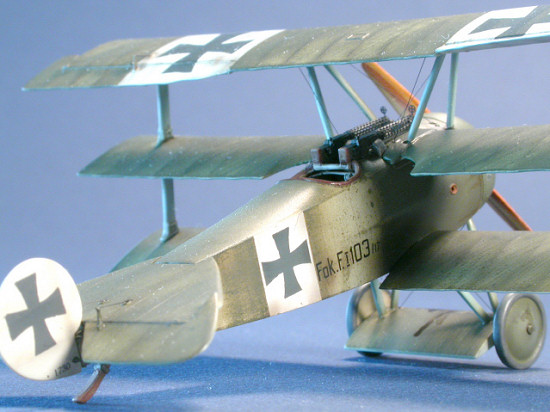 What an enigma Voss’ F.1
is. There has been a great debate over the color of the cowling, wheel covers
and if the upper surfaces were streaked over clear doped linen or turquoise
blue. I based my scheme on information from the article published in OVER THE
FRONT, Vol.20, No. 2 issue, titled "Fokker Triplane F.1 102/17 & 103/17: A
Photographic Study" by Terry Phillips and Aaron Weaver.
What an enigma Voss’ F.1
is. There has been a great debate over the color of the cowling, wheel covers
and if the upper surfaces were streaked over clear doped linen or turquoise
blue. I based my scheme on information from the article published in OVER THE
FRONT, Vol.20, No. 2 issue, titled "Fokker Triplane F.1 102/17 & 103/17: A
Photographic Study" by Terry Phillips and Aaron Weaver.
The sub assemblies were primed with Mr. Surfacer 1200, then pre-shaded with a mix of Tamiya Red-Brown and black. The lower surfaces were painted with a mix of Vallejo acrylics #971 Green-Grey, #972 Light Green Blue and white. The clear doped linen is a mix of Gunze acrylic “Hemp” and “Sail Color.” Next, I painted the national markings using the supplied vinyl masks. The various sub-assemblies were then sprayed with a coat of Floquil lacquer Flat Finish to protect the base color from the application of the streaks.
I used Humbrol paints for the streaking because of their superior dry brushing qualities. I made a mix of HJ-3 “Japanese Army Green A3" and HP-5 “US Marine Green,” which was lightly dry-brushed over the wings and fuselage. I then airbrushed a very thin mix of those colors over the streaks to help blend them in.
Decals:
I gave the model a coat of Floquil Flat finish before and after applying the kit decals for the serial number, stencils, and the “face.”
| CONSTRUCTION CONTINUES |
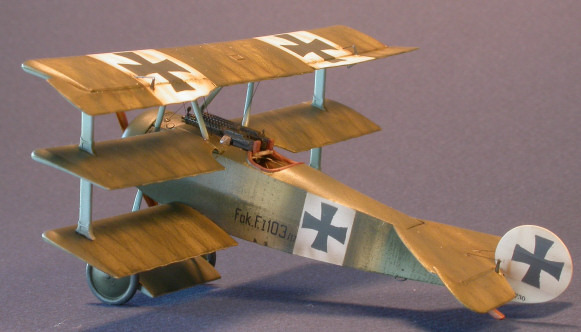 Final weathering was done
with a post shade of Tamiya Red-Brown/Black and small pin washes of Burnt
Umber and black to simulate castor oil stains.
Final weathering was done
with a post shade of Tamiya Red-Brown/Black and small pin washes of Burnt
Umber and black to simulate castor oil stains.
The propeller was first airbrushed with a coat of Floquil Foundation followed by streaks of artist oils.
The machine guns were first sprayed Floquil Grimy black then rubbed with a #2b pencil.
| CONCLUSIONS |
Though well-molded, I cannot see any justification for purchasing the Roseplane update. The cowling and aileron modifications are incomplete and though the horizontal tailplane is accurate some reshaping with a sanding stick will get you 99% there.
The Eduard kit makes a great little Dr.I, but falls short in producing a truly accurate F.1, though with a little scratch building you can get pretty close.
June 2006
Thanks to Eduard and Roseplane for the review samples.
If you would like your product reviewed fairly and fairly quickly, please contact the editor or see other details in the Note to Contributors.